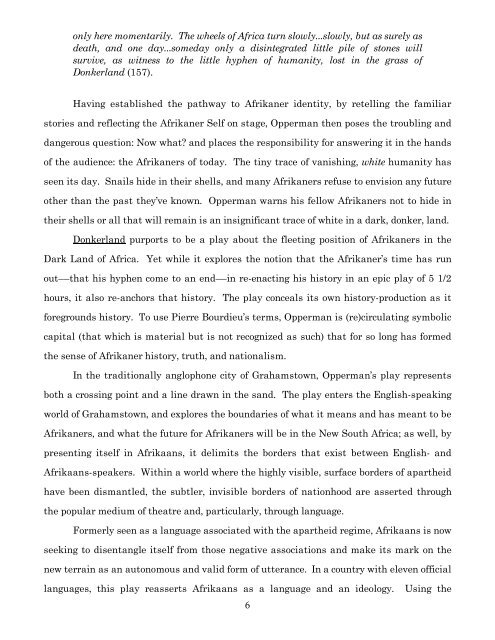De/Re-Constructing Borders - University of Minnesota
De/Re-Constructing Borders - University of Minnesota
De/Re-Constructing Borders - University of Minnesota
You also want an ePaper? Increase the reach of your titles
YUMPU automatically turns print PDFs into web optimized ePapers that Google loves.
only here momentarily. The wheels <strong>of</strong> Africa turn slowly...slowly, but as surely as<br />
death, and one day...someday only a disintegrated little pile <strong>of</strong> stones will<br />
survive, as witness to the little hyphen <strong>of</strong> humanity, lost in the grass <strong>of</strong><br />
Donkerland (157).<br />
Having established the pathway to Afrikaner identity, by retelling the familiar<br />
stories and reflecting the Afrikaner Self on stage, Opperman then poses the troubling and<br />
dangerous question: Now what? and places the responsibility for answering it in the hands<br />
<strong>of</strong> the audience: the Afrikaners <strong>of</strong> today. The tiny trace <strong>of</strong> vanishing, white humanity has<br />
seen its day. Snails hide in their shells, and many Afrikaners refuse to envision any future<br />
other than the past they’ve known. Opperman warns his fellow Afrikaners not to hide in<br />
their shells or all that will remain is an insignificant trace <strong>of</strong> white in a dark, donker, land.<br />
Donkerland purports to be a play about the fleeting position <strong>of</strong> Afrikaners in the<br />
Dark Land <strong>of</strong> Africa. Yet while it explores the notion that the Afrikaner’s time has run<br />
out––that his hyphen come to an end––in re-enacting his history in an epic play <strong>of</strong> 5 1/2<br />
hours, it also re-anchors that history. The play conceals its own history-production as it<br />
foregrounds history. To use Pierre Bourdieu’s terms, Opperman is (re)circulating symbolic<br />
capital (that which is material but is not recognized as such) that for so long has formed<br />
the sense <strong>of</strong> Afrikaner history, truth, and nationalism.<br />
In the traditionally anglophone city <strong>of</strong> Grahamstown, Opperman’s play represents<br />
both a crossing point and a line drawn in the sand. The play enters the English-speaking<br />
world <strong>of</strong> Grahamstown, and explores the boundaries <strong>of</strong> what it means and has meant to be<br />
Afrikaners, and what the future for Afrikaners will be in the New South Africa; as well, by<br />
presenting itself in Afrikaans, it delimits the borders that exist between English- and<br />
Afrikaans-speakers. Within a world where the highly visible, surface borders <strong>of</strong> apartheid<br />
have been dismantled, the subtler, invisible borders <strong>of</strong> nationhood are asserted through<br />
the popular medium <strong>of</strong> theatre and, particularly, through language.<br />
Formerly seen as a language associated with the apartheid regime, Afrikaans is now<br />
seeking to disentangle itself from those negative associations and make its mark on the<br />
new terrain as an autonomous and valid form <strong>of</strong> utterance. In a country with eleven <strong>of</strong>ficial<br />
languages, this play reasserts Afrikaans as a language and an ideology. Using the<br />
6
















